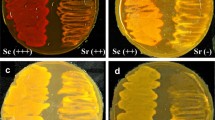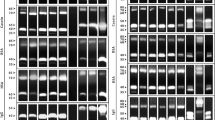Abstract
Pseudallescheria boydii is a ubiquitous filamentous fungus capable of causing invasive disease in humans. In the present study, using sodium dodecyl sulfate–polyacrylamide gels containing bovine serum albumin as co-polymerized substrate, we identified a 28-kDa proteolytic activity released to the extracellular environment by mycelia of P. boydii. This peptidase was detected during the growth of P. boydii in Sabouraud-dextrose medium for 13 days and reached its maximal production on day 7. The 28-kDa peptidase was active in acidic pH (5.5) and had its activity completely blocked by 1,10-phenanthroline, a potent zinc-metallopeptidase inhibitor. Two other metallopeptidase inhibitors, EDTA and EGTA, were also tested and no alterations were observed in the activity of the 28-kDa extracellular peptidase. Likewise, E-64 (a cysteine peptidase inhibitor), phenylmethylsulphonyl fluoride (a serine peptidase inhibitor), and pepstatin A (an aspartyl peptidase inhibitor) did not significantly alter the enzymatic behavior. Collectively, we described for the first time the expression of an extracellular metallopeptidase in the human opportunistic fungal pathogen P. boydii.



Similar content being viewed by others
Literature Cited
Abdel-Rahman SM (2001) Trichophyton tonsurans exocellular protease expression: correlation with clinical presentation in tinea capitis. Clin Exp Dermatol 27:268–271
Cimon B, Carrère J, Vinatier JF, Chazalette JP, Chabasse D, Bouchara JP (2000) Clinical significance of Scedosporium apiospermum in cystic fibrosis. Eur J Clin Microbiol Infect Dis 19:53–56
Costa EMMB, Santos ALS, Cardoso AS, Portela MB, Abreu CM, Alviano CS, Hagler AN, Soares RMA (2003) Heterogeneity of metallo and serine extracellular proteinases in oral clinical isolates of Candida albicans in HIV-positive and healthy children from Rio de Janeiro, Brazil. FEMS Immunol Med Microbiol 38:173–180
Cremer G, Boiron P (1996) Epidemiology and biology of Scedosporium species. J Mycol Med 6:165–171
Ginter G, Petutschnig B, Pierer G, Soyer HP, Reischle S, Kern T, de Hoog S (1998) Atypical cutaneous pseudallescheriosis refractory to antifungal agents. Mycoses 42:507–511
Goldman D, Lee SC, Casadevall A (1994) Pathogenesis of pulmonary Cryptococcus neoformans infection in the rat. Infect Immun 62:4755–4781
Heussen C, Dowdle EB (1980) Electrophoretic analysis of plasminogen activators in polyacrylamide gels containing sodium dodecyl sulfate and copolymerized substrates. Anal Biochem 102:196–202
Hooper NM (1994) Families of zinc metalloproteases. FEBS Lett 354:1–6
Hube B (2000) Extracellular peptidases of human pathogenic fungi. Contrib Microbiol 5:126–137
Laemmli UK (1970) Cleavage of structural proteins during the assembly of the head of bacteriophage T4. Nature 227:680–685
Larcher G, Cimon B, Symoens F, Tronchin G, Chabasse D, Bouchara JP (1996) A 33 kDa serine peptidase from Scedosporium apiospermum. Biochem J 315:119–126
Lowry OH, Rosebrough NJ, Farr AL, Randall RJ (1951) Protein measurement with the Folin phenol reagent. J Biol Chem 193:265–275
Markaryan A, Morozova I, Yu J, Kolattukudy PE (1994) Purification and characterization of an elastinolytic metalloprotease from Aspergillus fumigatus and immunoelectron microscopic evidence of secretion of this enzyme by the fungus invading the murine lung. Infect Immun 62:2149–2157
Miyoshi S, Shinoda S (2000) Microbial metalloproteases and pathogenesis. Microb Infect 2:91–98
Monod M, Capoccia S, Lechenne B, Zaugg C, Holdom M, Jousson O (2002) Secreted proteases from pathogenic fungi. Int J Med Microbiol 292:405–419
Patterson TF, Andriole VT, Zervos MJ, Therasse D, Kauffman CA (1990) The epidemiology of pseudallescheriasis complicating transplantation: nosocomial and community-acquired infection. Mycoses 33:297–302
Pinto MR, Mulloy B, Haido RMT, Travassos LR, Barreto-Bergter E (2001) A peptidorhamnomannan from the mycelium of Pseudallescheria boydii is a potential diagnostic antigen of this emerging human pathogen. Microbiology 147:1499–1506
Pinto MR, Rodrigues ML, Travassos LR, Haido RMT, Wait R, Barreto-Bergter E (2002) Characterization of glucosylceramides in Pseudallescheria boydii and their involvement in fungal differentiation. Glycobiology 12:251–260
Pinto MR, de Sá ACM, Limongi CL, Rozental S, Santos ALS, Barreto-Bergter E (2004) Involvement of peptidorhamnomannan in the interaction of Pseudallescheria boydii and HEp2 cells. Microb Infect 6:1259–1267
Rao MB, Tanksale AM, Ghatge MS, Deshpande VV (1998) Molecular and biotechnological aspects of microbial proteases. Microbiol Mol Biol Rev 62:597–635
Rippon JW (1998) Pseudallescheriasis. In: Rippon JW (eds). Medical mycology. The pathogenic fungi and the pathogenic actinomycetes. Philadelphia: WB Saunders. pp 651–680
Santos ALS, Soares RMA (2005) Candida guilliermondii isolated from HIV-infected human secretes a 50 kDa serine proteinase that cleaves a broad spectrum of proteinaceous substrates. FEMS Immunol Med Microbiol 43:13–20
Sukhosyrova EA, Nikitina ZK, Yakovleva MB, Veshchikova EV, Bykov VA (2003) Characteristics of collagenolytic enzymes secreted by deuteromycete fungi Aspergillus flavus. Bull Exp Biol Med 135:447–451
Trados S, Workowski K, Siegel R, Hunter S, Schwartz D (1998) Pathology of hyalohyphomycosis caused by Scedosporium apiospermum (Pseudallescheria boydii), an emerging mycosis. Human Pathol 29:1266–1272
van Burik JAH, Magee PT (2001) Aspects of fungal pathogenesis in humans. Annu Rev Microbiol 55:743–772
Wróblewski F, Ladue JS (1955) Lactic dehydrogenase activity in blood. Proc Soc Exp Biol Med 90:210–213
Acknowledgments
This study was supported by grants from Conselho Nacional de Desenvolvimento Científico e Tecnológico (CNPq), Financiadora de Estudos e Projetos (FINEP), Fundação de Amparo à Pesquisa do Estado do Rio de Janeiro (FAPERJ), Fundação Universitária José Bonifácio (FUJB) and Programa de Apoio a Núcleos de Excelência (PRONEX).
Author information
Authors and Affiliations
Corresponding author
Rights and permissions
About this article
Cite this article
Silva, B.A.d., Santos, A.L.S.d., Barreto-Bergter, E. et al. Extracellular Peptidase in the Fungal Pathogen Pseudallescheria boydii . Curr Microbiol 53, 18–22 (2006). https://doi.org/10.1007/s00284-005-0156-1
Received:
Accepted:
Published:
Issue Date:
DOI: https://doi.org/10.1007/s00284-005-0156-1




